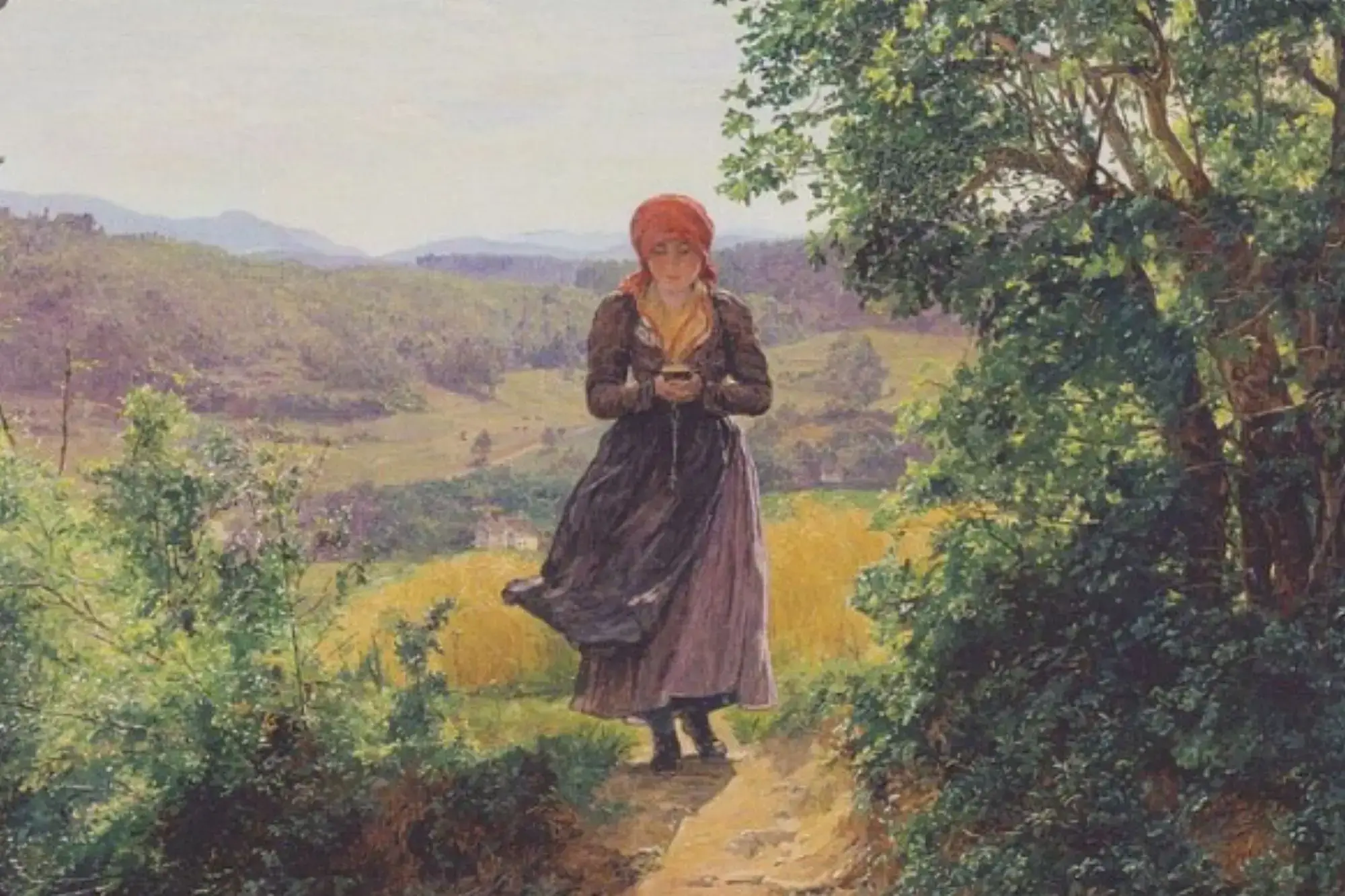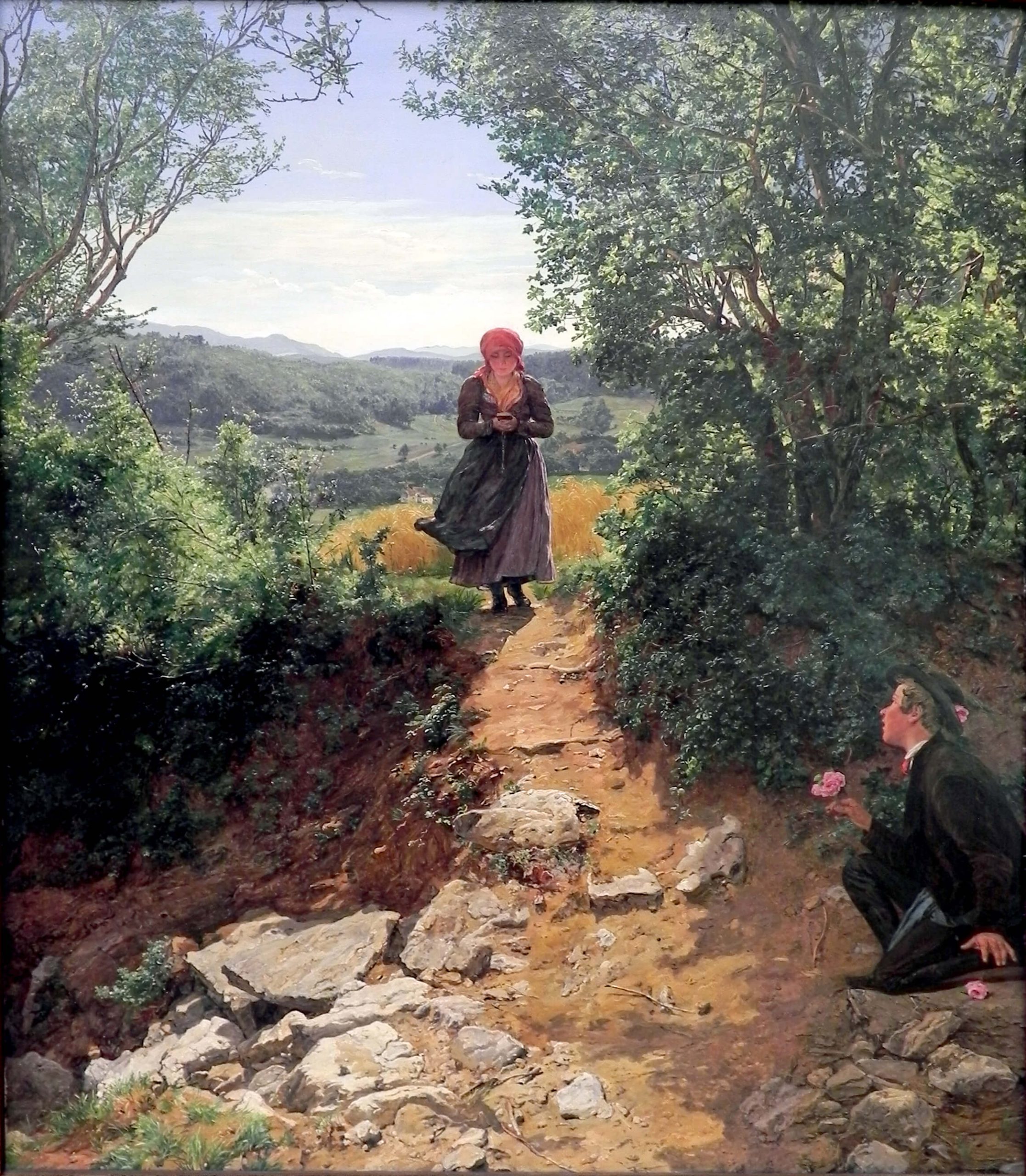
People Claim This 1860 ‘Time Travel’ Painting Seems To Show A Woman Holding A ‘Smartphone’
A closer look at “The Expected One,” a painting by 19th century Austrian artist Ferdinand Georg Waldmüller.
By: Brian Anderson | Vice
Peter Russell and his partner were strolling through the Neue Pinakothek, the museum of 18th and 19th century art in Munich, when they saw her.
She’s walking down a path, seemingly unfocused on what’s coming around a slight bend: a rosy-cheeked boy on one knee with a pink flower at the ready for wooing her. Her gaze is, for the moment, frozen downward at a slight angle, focused on a small object she cradles with both hands in the way so many of us walk around nowadays absorbed in our smartphones.
This is “The Expected One,” a painting by Austrian painter Ferdinand Georg Waldmüller from 1860.
Russell, a retired local Glasgow government officer, told me he recalled the artwork this past summer at a translators’ conference. It was about a year after he and his partner came face to face with the painting on that fateful Bavarian holiday. Now Russell and a female colleague, he explained, had found themselves talking about “the importance of context.” That’s when he whipped out his phone to show her an image of “The Expected One.”
“What strikes me most is how much a change in technology has changed the interpretation of the painting, and in a way has leveraged its entire context,” said Russell, who now occasionally blogs about culture and writes poetry.

The painting has since left enough of an impression on Russell that he’d even share it in response to a tweet last month from the @VICE Twitter account, after it posted a story I wrote over the summer about a certain painting from 1937 that depicts, among other things, a man holding a certain something that so resembles an iPhone as to be uncanny.
Russell’s reply tweet, noting a similar sort of striking resemblance going on in “The Expected One,” is how I first caught wind of the Waldmüller painting, a work that may actually date back to 1850, according to the gallery’s website. In which case, the point remains.
What’s dimmer to trace back is whether he’s the first observer to publicly call it out. Russell told me he wasn’t aware of anyone else having shared the painting “in this way” (“usually,” he added, “if your idea is that good, someone else has already had it”). There is at least one remixed version of “The Expected One” floating around Pinterest and forwarded to me. The image has been doctored to include a cone of light thrown off the woman’s “phone.”
Which is all to say, of course the woman in the painting isn’t holding a smartphone.
“The girl in this Waldmüller painting is not playing with her new iPhone X, but is off to church holding a little prayer book in her hands,” Gerald Weinpolter, CEO of the art agency austrian-paintings.at, told me.
It wouldn’t be the first time the essence of an inanimate object—its compositional weight, the way it captivates, its aura—in an artistic depiction of a time pre-dating even electricity has transmogrified through the filters of our modern hyper-connectivity.
- See something strange in an image that predates the internet, digital age, or dawn of electricity? Contact this writer at brian.anderson@vice.com.
In “The Expected One,” the woman’s body language certainly makes it appear as if she’s looking at a phone, to the degree you can imagine her being labelled just another “distracted walker” exhibiting signs of so-called “text neck” if she were walking down the street in 2017. And as a particularly time travel-obsessed acquaintance of mine recently pointed out to me after I showed them the original (undoctored) version of the painting, the woman’s face seems lit up from below as if washed in screen glow. The shadowing all seems cast forward save her chin, lips, and cheeks, which almost appear brighter than one might think they would considering Waldmüller’s brushstrokes otherwise have her backlit.
“The big change is that in 1850 or 1860, every single viewer would have identified the item that the girl is absorbed in as a hymnal or prayer book,” Russell said. “Today, no one could fail to see the resemblance to the scene of a teenage girl absorbed in social media on their smartphone.”
Back at the translator’s conference, Russell’s colleague offered another take: “She’ll be on a dating app,” she cracked, imagining the bonneted young woman cooly rejecting her would-be suitor in the way she might if only she were swiping through Tinder today on an iPhone. “Tough luck, pal.”
Previously:
Please drop your thoughts below in the comment section.
* * *
NEXT UP!
Proof of The Parallel Universe? Nazi Coin From 2039 In Mexico Sparks Bizarre Theories
For a long time, alternative universes have been used as a plot for a novel or simply a story for a movie. But there are many who wonder what their life would be like in a parallel universe, or if there is an alternative version of themselves in another dimension. For what scientists have also spent time investigating the potential of alternative realities for decades.
Over the years, scientists have exposed multiple theories, some of which have real evidence to back them up. So, if any of these theories is correct, there is a universe somewhere different from ours. One of the most popular theories of the alternative universe is string theory.
According to this theory, we live in a multiverse of nine dimensions, with only three dimensions visible to us.
* * *
READ MORE: Time Traveller From 2858′ Issues Warning About ‘How The World Will End
Fascinating Story: The Man From Taured Who Vanished As Mysterious As He Came!
Telegram: Stay connected and get the latest updates by following us on Telegram!
We’d love to hear from you! If you have a comment about this article or if you have a tip for a future Collective Spark Story please let us know below in the comment section.
